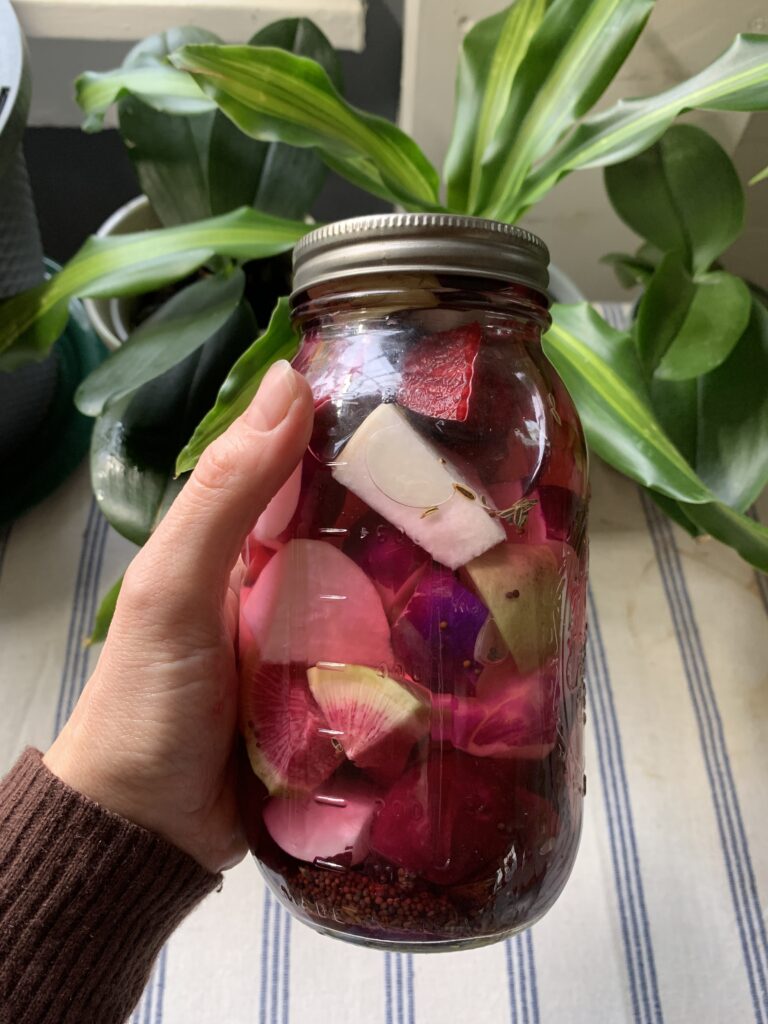How to: Lacto-Fermented Veggies

Lacto-fermentation is the process that produces traditional dill pickles, kimchi, and real sauerkraut. This simple fermentation process requires nothing more than salt, vegetables, and water—no canning, no fancy equipment.
The lacto-fermentation process works because bacteria that could be harmful to us can’t tolerate much salt, while healthy bacteria can. Lacto-fermentation wipes out the bad bacteria in its first stage, then lets the healthy bacteria get to work during stage two.
The good bacteria is known as Lactobacillus. Lactobacillus bacteria convert sugars naturally present in fruit or vegetables into lactic acid. Lactic acid is a natural preservative that helps fight bad bacteria and preserves not only the flavor and texture of food but also its nutrients.
Some strains of Lactobacillus bacteria support digestion and immunity and may help protect against inflammation and chronic disease, including some types of cancer. Different strains of bacteria within the same genus, or family, have strain-specific health benefits.
Traditional lacto-fermentation involves submerging vegetables in a brine solution— salt and water. The salt-brine method involves two stages:
In stage one of lacto-fermentation, vegetables are submerged in a brine that is salty enough to kill off harmful bacteria. The Lactobacillus good guys survive this stage and begin stage two.
In stage two of lacto-fermentation, the Lactobacillus organisms begin converting lactose and other sugars present in the food into lactic acid. This creates an acidic environment that safely preserves the vegetables – and give lacto-femrneted foods their distinctive tangy flavor.
Lacto fermented carrots
Ingredients
- 2 teaspoons salt, kosher or other non-iodized salt
- 3 cups water, filtered
- 1 1/2 pounds carrots
In a medium bowl, dissolve the salt in the filtered water.
- Wash the carrots. Slice off the stem ends and tips and peel the carrots.
- Cut the carrots short enough to fit into a pint jar with a little headspace above.
- Cut the carrots lengthwise into quarters.
- Place two clean glass pint jars on their sides and pack the carrots in so tightly that it is impossible to squeeze in even one more carrot.
- Once the jars are full, set them upright. Pour the salt brine over the carrots. They must be completely covered by the brine.
- Cover the jars loosely with lids. Place the jars on small plates to catch the overflow that may happen during active fermentation. Leave the jar at room temperature for 24 to 48 hours.
- After the first 24 hours, remove the lids and check on the ferment. You should start to see some bubbles and it will begin to develop a mild, refreshingly sour smell (like a light version of sauerkraut).
- Once you see and smell the signs that the carrots are actively fermenting, transfer the jars to the door of your refrigerator. This is the warmest part of the fridge but still cooler than room temperature—perfect for your carrots to keep slowlyfermenting.
- Fermented carrots are ready to eat 1 to 2 weeks after you make them. Enjoy them straight out of the jar as a pickle, or use them in recipes.
Source: thespruceeats.com

